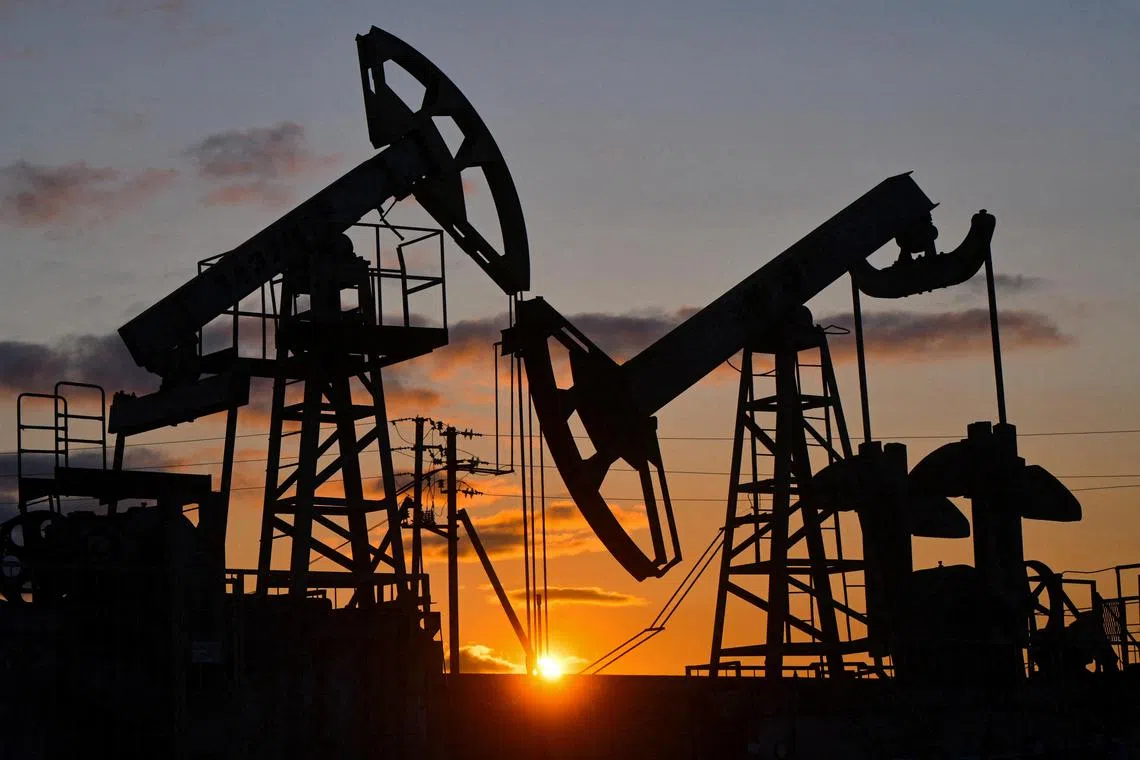Oil prices ‘melt up’ in march towards US$100 a barrel
Sign up now: Get ST's newsletters delivered to your inbox

Climbing oil prices increase energy costs for consumers and businesses, weighing on the global economy.
PHOTO: REUTERS
Follow topic:
NEW YORK – Many energy analysts think that oil prices will soon rise above US$100 a barrel for the first time in more than a year, since the turmoil that followed Russia’s invasion of Ukraine.
The price of Brent crude, the international benchmark, has gained about 30 per cent since the start of July, trading at about US$96.50 a barrel on Wednesday.
“I think prices are starting to melt up,” said Mr Robert McNally, president of research firm Rapidan Energy Group.
Driving the rise, analysts say, is the deep reduction in oil output orchestrated by Saudi Arabia over the past year. The kingdom’s ability and willingness to add and subtract supplies gives it substantial sway over the market for this crucial commodity.
Climbing oil prices increase energy costs for consumers and businesses, weighing on the global economy.
In the United States, the price of crude oil accounts for about half the price of petrol.
Rising pump prices are squeezing motorists, complicating the Federal Reserve’s fight against inflation and stoking concerns over the Biden administration’s economic stewardship.
The Saudi-led oil producers’ group known as Opec+ is, in effect, withholding more than five million barrels a day, or the equivalent of about 5 per cent of global supplies.
The Saudis “are starving the market of oil”, said Dr Gary Ross, chief executive of trading firm Black Gold Investors.
Dr Ross said that the coming weeks and months may answer why the Saudis are keeping their output at about nine million barrels a day, nearly two million barrels a day less than a year ago.
“We will find out what price they want when they decide to increase supply,” he said.
Speaking last week at a conference, Prince Abdulaziz bin Salman, the Saudi Energy Minister, seemed to signal that Saudi Arabia was not ready to pump more, even with prices of Brent crude reaching well over US$90 a barrel.
While denying that Saudi Arabia was “jacking up prices”, he said that the kingdom wanted to wait until there was “data and clarity” before putting more oil on the market. The Saudis say they worry about the risk that new supplies may sink prices when recession fears are still in the air.
It is a tactic that could, by stimulating more oil output from other countries or dampening demand, lead to the fall in oil prices that the Saudis say they are trying to avoid.
“Higher prices in the near term could make for more downside for prices next year,” analysts at Citigroup wrote recently.
But global demand for oil has grown strongly of late, outstripping supply.
Despite China’s slumping economy, demand in the world’s largest importer is expected to increase by a healthy 1.6 million barrels a day in 2023, about three-quarters of overall global growth, according to the International Energy Agency (IEA).
Rapidan’s Mr McNally estimates that in the fourth quarter of 2023, global demand for oil will exceed output by 1.8 million barrels a day, or nearly 2 per cent of the market.
Already, this deficit in supply is leading to a rapid drawdown of oil held at key storage areas such as Cushing, Oklahoma. Even if the Organisation of Petroleum Exporting Countries and its allies, including Russia, begin unwinding the cuts in 2024, as some analysts expect, oil stocks will be “uncomfortably low”, increasing the risk of price volatility, the IEA recently warned.
The strength of demand is also seen in the hefty profits being made by refiners, especially on diesel. The heavy grades of crude that the Saudis are withholding are especially useful for making diesel, which is used in trucking, agriculture and industry.
Refiners seeking crude for diesel are willing to pay a premium because they are making “three times the usual” profits, said Mr Viktor Katona, an analyst at research firm Kpler.
In a move that will further tighten the market, Russia recently banned most exports of diesel and other fuel to help ease domestic prices.
It is the Saudis, though, who have seized control of the market over the past year by orchestrating a series of cuts, including a unilateral trim of one million barrels a day starting in July that the Prince called a “lollipop”.
The Saudis spurred prices further in September when they said that the latest production cut would extend until the end of the year. Russia also promised a reduction in exports of 300,000 barrels a day.
Russia is benefiting from the Saudi-led actions. The IEA estimates that Russia had US$17.1 billion (S$23.5 billion) in oil export revenues in August, the highest monthly total in nearly a year.
The Saudis, though, are probably not entirely happy with the situation. They are producing well below their capacity and giving up a share of the market. Paradoxically, the national oil company, Saudi Aramco, is spending billions of dollars to increase the amount of oil it can pump.
Mr McNally, who served as an energy adviser to former president George W. Bush, said he thought that the Saudis were nearing a point where they would seriously consider increasing supplies.
“I think the Saudis aren’t going to deliberately let things get out of hand,” he said. NYTIMES

